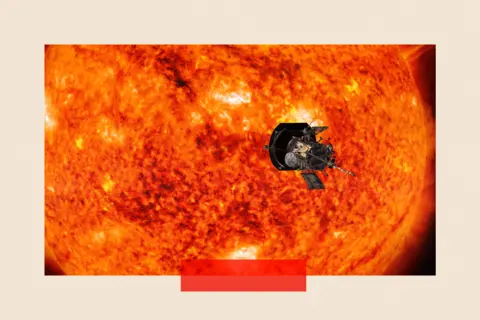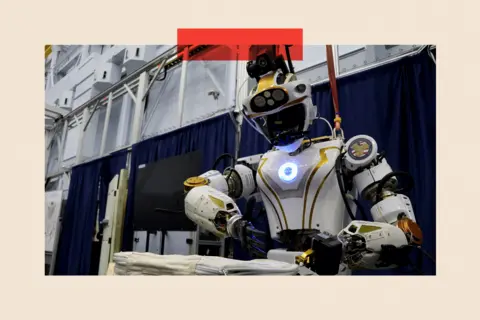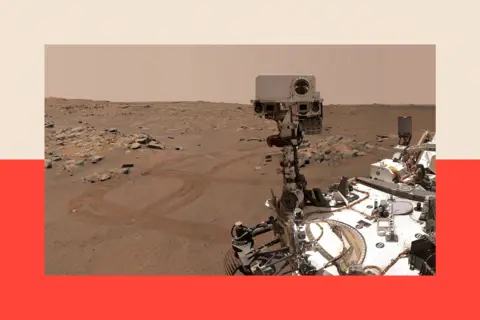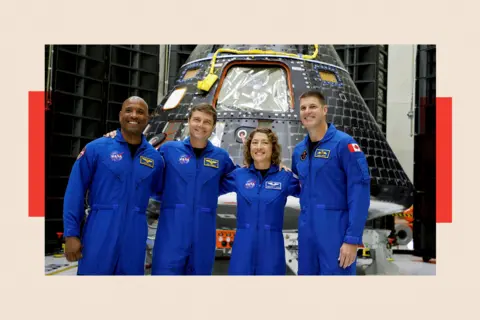AI Research
Could robots really replace human astronauts?


 BBC
BBCOn Christmas Eve, an autonomous spacecraft flew past the Sun, closer than any human-made object before it. Swooping through the atmosphere, Nasa’s Parker Solar Probe was on a mission to discover more about the Sun, including how it affects space weather on Earth.
This was a landmark moment for humanity – but one without any human directly involved, as the spacecraft carried out its pre-programmed tasks by itself as it flew past the sun, with no communication with Earth at all.
Robotic probes have been sent across the solar system for the last six decades, reaching destinations impossible for humans. During its 10-day flyby, the Parker Solar Probe experienced temperatures of 1000C.
But the success of these autonomous spacecraft – coupled with the rise of new advanced artificial intelligence – raises the question of what role humans might play in future space exploration.
 NASA
NASASome scientists question whether human astronauts are going to be needed at all.
“Robots are developing fast, and the case for sending humans is getting weaker all the time,” says Lord Martin Rees, the UK’s Astronomer Royal. “I don’t think any taxpayer’s money should be used to send humans into space.”
He also points to the risk to humans.
“The only case for sending humans [there] is as an adventure, an experience for wealthy people, and that should be funded privately,” he argues.
Andrew Coates, a physicist from University College London, agrees. “For serious space exploration, I much prefer robotics,” he says. “[They] go much further and do more things.”
 NASA
NASAThey are also cheaper than humans, he argues. “And as AI progresses, the robots can be cleverer and cleverer.”
But what does that mean for future generations of budding astronauts – and surely there are certain functions that humans can do in space but which robots, however advanced, never could?
Rovers versus mankind
Robotic spacecraft have visited every planet in the solar system, as well as many asteroids and comets, but humans have only gone to two destinations: Earth’s orbit and the Moon.
In all, about 700 people have been to space, since the earliest in 1961, when Yuri Gagarin from the then-Soviet Union became the first cosmic explorer. Most of those have been into orbit (circling the Earth) or suborbit (short vertical hops into space lasting minutes, on vehicles like the US company Blue Origin’s New Shepard rocket).
“Prestige will always be a reason that we have humans in space,” says Dr Kelly Weinersmith, a biologist at Rice University, Texas and co-author of A City on Mars. “It seems to have been agreed upon as a great way to show that your political system is effective and your people are brilliant.”
But aside from an innate desire to explore, or a sense of prestige, humans also carry out research and experiments in Earth’s orbit, such as on the International Space Station, and use these to advance science.
 NASA
NASARobots can contribute to that scientific research, with the ability to travel to locations inhospitable to humans, where they can use instruments to study and probe the atmospheres and surfaces.
“Humans are more versatile and we get stuff done faster than a robot, but we’re really hard and expensive to keep alive in space,” says Dr Weinersmith.
In her 2024 Booker Prize-winning novel Orbital, author Samantha Harvey puts it more lyrically: “A robot has no need for hydration, nutrients, excretion, sleep… It wants and asks for nothing.”
But there are downsides. Many robots are slow and methodical – for example on Mars, the rovers (remote-controlled motor vehicles) trundle along at barely 0.1mph.
“AI can beat human beings at chess, but does that mean they’ll be able to beat human beings in exploring environments?” asks Dr Ian Crawford, a planetary scientist at the University of London. “I just don’t think we know.”
He does, however, believe that AI algorithms might enable rovers to be “more efficient”.
AI assistants and humanoid robots
Technology can play a part in complementing human space travel by freeing up astronauts from certain tasks to allow them to focus on more important research.
“[AI could be used to] automate tedious tasks,” explains Dr Kiri Wagstaff, a computer and planetary scientist in the US who previously worked at Nasa’s Jet Propulsion Laboratory in California. “On the surface of a planet, humans get tired and lose focus, but machines won’t.”
The challenge is that vast amounts of power are needed to operate systems like large language models (LLM), which can understand and generate human language by processing vast amounts of text data. “We are not at the point of being able to run an LLM on a Mars rover,” says Dr Wagstaff.
“The rovers’ processors run at about a tenth [of the speed] that your smartphone has” – meaning they are unable to cope with the intense demands of running an LLM.
Complex humanoid machines with robotic arms and limbs are another form of technology that could take on basic tasks and functions in space, particularly as they more closely mimic the physical capabilities of humans.
 NASA
NASANasa’s Valkyrie robot was built by the Johnson Space Center to compete in a 2013 robotics challenge trial. Weighing 300lb and standing at 6ft2in, it looks not unlike a Star Wars Stormtrooper, but it is one of an increasing number of human-like machines with superhuman abilities.
Long before the Valkyrie was created, Nasa’s Robonaut was the first humanoid robot designed for use in space, taking on tasks that were otherwise performed by humans.
Its specially designed hands meant it could use the same tools as astronauts and carry out complex, delicate tasks like grasping objects or flicking switches, that were too challenging for other robotic systems.
A later model of the Robonaut was flown to the International Space Station on the space shuttle Discovery in 2011, where it helped with maintenance and assembly.
 Reuters
Reuters“If we need to change a component or clean a solar panel, we could do that robotically,” says Dr Shaun Azimi, lead of the dexterous robotics team at Nasa’s Johnson Space Center in Texas. “We see robots as a way to secure these habitats when humans aren’t around.”
He argues that robots could be useful, not to replace human explorers but to work alongside them.
Some robots are already working on other planets without humans, sometimes even making decisions on their own. Nasa’s Curiosity rover, for example, is exploring a region called Gale Crater on Mars and autonomously performs some of its science without human input.
“You can direct the rover to take pictures of a scene, look for rocks that might fit science priorities for the mission, and then autonomously fire its laser at that target,” says Dr Wagstaff.
“It can get a reading of a particular rock and send it back to Earth while the humans are still asleep.”
 NASA
NASABut the capabilities of rovers like Curiosity are limited by their slow pace. And there is something else they cannot compete with too. That is, humans have the added bonus of inspiring people back on Earth in a way that machines cannot.
“Inspiration is something that is intangible,” argues Prof Coates.
Leroy Chiao, a retired Nasa astronaut who went on three flights to space in the 1990s and 2000s on Nasa’s Space Shuttle and to the International Space Station, agrees. “Humans relate when humans are doing something.
“The general public is excited about robotic missions. But I would expect the first human on Mars to be even bigger than the first Moon landing.”
Life on Mars?
Humans have not travelled further than Earth’s orbit since December 1972, when the last Apollo mission visited the Moon. Nasa is hoping to return humans there this decade with its Artemis programme.
The next crewed mission will see four astronauts fly around the Moon in 2026. A further mission, scheduled for 2027, will see Nasa astronauts land on the Moon’s surface.
 Reuters
ReutersThe Chinese space agency, meanwhile, also wants to send astronauts to the Moon.
Elsewhere Elon Musk, CEO of the US company SpaceX, has his own plans related to space. He has said that his long-term plan is to create a colony on Mars, where humans could land.
His idea is to use Starship, a vast new vehicle that his company is developing, to transport up to 100 people there at a time, with the aim for there to be a million people on Mars in 20 years.
“Musk is arguing we need to move to Mars because that could be a backup for humanity if something catastrophic happens on Earth,” explains Dr Weinersmith. “If you buy that argument, then sending humans into space is necessary.”
However, there are large unknowns about living on Mars, including myriad technical challenges that she says remain unsolved.
“Maybe babies can’t develop in that environment,” she says. “There [are] ethical questions [like this] that we don’t have the answers to.
“I think we should be slowing down.”
Lord Rees has a vision of his own, though, in which human and robotic exploration might merge to the point that humans themselves are part-machine to cope with extreme environments. “I can imagine they will use all of the techniques of genetic modification, cyborg add-ons, and so on, to cope with very hostile environments,” he says.
“We may have a new species that will be happy to live on Mars.”
Until then, however, humans are likely to continue their small steps into the cosmos, on a path long trodden by robotic explorers before them.
Top image credit: NASA
BBC InDepth is the new home on the website and app for the best analysis and expertise from our top journalists. Under a distinctive new brand, we’ll bring you fresh perspectives that challenge assumptions, and deep reporting on the biggest issues to help you make sense of a complex world. And we’ll be showcasing thought-provoking content from across BBC Sounds and iPlayer too. We’re starting small but thinking big, and we want to know what you think – you can send us your feedback by clicking on the button below.
AI Research
Examining Tim Draper’s AI digital twin program – NBC Bay Area

Remember a hologram of Tupac Shakur that made headlines back at Coachella in 2012?
It was a digital creation made to sing along on stage.
Now imagine a similar hologram, but one that can use artificial intelligence to bring us all the experience and knowledge in someone’s life — in this case, a well-known Silicon Valley venture capitalist.
“It’s going to change the way we think about the world, and we’ll evolve with it,” venture capitalist Tim Draper said.
A digital twin has been created of Draper. The so-called twin is a hologram using AI to scan everything about Draper.
The twin can answer questions in multiple locations at once and Draper’s twins are currently installed at Kennedy Airport in New York and at a Midwestern University.
Still, the twins have some learning to do as they still get the occasional question wrong.
The box holding one of the twins is reportedly about $100,000 each.
Draper is so known and regarded in tech circles that he has his own university, where the Silicon Valley venture capitalist now mentors young entrepreneurs.
One of the many things Draper has invested in deeply is AI after making a splash with some other big name investments like Tesla and Robinhood.
“You’re seeing the excitement period of an industry being created,” Draper said. “We’re in that period of elation. Where wow, it’s blowing my mind.”
Draper is now offering some very simple advice to young techies to make sure they have the right skills to stay employed in the shifting Silicon Valley landscape.
AI Research
Prediction: Oracle Will Surpass Amazon, Microsoft, and Google to Become the Top Cloud for Artificial Intelligence (AI) By 2031
Key Points
-
Oracle is on its way to becoming the best cloud for AI and high-performance computing.
-
Oracle multicloud is cutting networking complexity and reducing data transfer latency.
-
OpenAI will need to raise capital or generate cash flow to afford its $300 billion cloud deal with Oracle.
On Sept. 10, Oracle (NYSE: ORCL) stock popped 36% in response to a massive increase in customer orders for Oracle’s cloud services.
Oracle forecasts that revenue from its Oracle Cloud Infrastructure (OCI) segment could grow from around $10 billion in its last fiscal year (fiscal 2025), to $18 billion in its current fiscal year (fiscal 2026), $32 billion in fiscal 2027, $73 billion in fiscal 2028, $114 billion in fiscal 2029, and $144 billion in fiscal 2030 — corresponding with calendar year 2031.
Where to invest $1,000 right now? Our analyst team just revealed what they believe are the 10 best stocks to buy right now. Learn More »
For context, Amazon Web Services (AWS) generated over $60 billion in net sales in the first half of 2025 — so a $120 billion annual run rate. Microsoft, which just wrapped up its fiscal 2025 year, reported $106 billion in Intelligent Cloud revenue. And Alphabet‘s Google Cloud generated $26 billion in revenue in the first half of 2025. This means that OCI is forecast to exceed the current size of Google Cloud within three years, the current size of Microsoft Azure within four years, and the current size of AWS within five years.
Here’s why Oracle is winning cloud contracts from leading artificial intelligence (AI) companies like OpenAI, and why the company could become the top cloud for AI within the next five years.

Image source: Getty Images.
The future of cloud computing
Oracle’s push into cloud infrastructure is arguably its boldest bet in the company’s history. Oracle isn’t cutting corners, either; it is bringing on dozens of data centers online in just a few years. It has built 34 multicloud data centers and should have another 37 online in less than a year.
These multicloud data centers are unique because they allow an organization to use services or workloads from two or more cloud providers, such as AWS, Microsoft Azure, Google Cloud, and OCI. All of these clouds can work with the Oracle database. The idea is to allow customers to select the best cloud service for each task.
AWS, Azure, and Google Cloud all have multicloud strategies too, but the big difference is that Oracle is embedding native versions of its infrastructure (Oracle Autonomous Database and Exadata Database Service) inside the big three clouds to boost performance and decrease latency. Examples include Oracle Database@AWS, Oracle Database@Azure, and Oracle Database@Google Cloud. The “big three” are more about managing workloads rather than integrating them natively.
The buildout of OCI as a formidable alternative to the big three, paired with Oracle’s ultra-modern data centers, put Oracle on the cutting edge of data center workflow. According to Oracle, OCI can achieve 50% better price-to-performance and 3.5 times time savings for high-performance cloud computing workflows compared to the previous generation of computing.
Race to the clouds
Oracle is purpose-building its cloud from scratch specifically for AI, whereas the majority of AWS, Microsoft Azure, and Google Cloud handle non-AI tasks, like basic compute and storage, database and analytics, networking, etc. So while Oracle will likely become the biggest cloud for AI if it hits its fiscal 2030 OCI revenue target of $144 billion, it still may be a smaller cloud by total revenue compared to the more established giants.
Still, Oracle is achieving milestones that are impossible to ignore — laying the foundation for Oracle to be the go-to cloud for AI. It exited the recent quarter with a 359% increase in its contract backlog, bringing the total to $455 billion. Reports indicate that Oracle landed a multiyear $300 billion contract with OpenAI. To afford that deal, OpenAI will need to start generating more cash flow.
On Sept. 11 — two days after Oracle reported earnings — OpenAI and Microsoft released a joint statement to transition OpenAI from a pure-play nonprofit to a nonprofit owning a majority stake in a Public Benefit Corporation (PBC). A PBC is like a corporation with mission-backed guardrails. The aim is to generate a profit, but only if it fulfills a mission. Still, OpenAI’s transition could allow it to raise billions more in funding, which would presumably help fund its deal with OCI even if OpenAI isn’t generating positive free cash flow.
OpenAI, as the cornerstone of Oracle’s backlog, has its pros and cons. On the one hand, it demonstrates that one of the most cutting-edge AI companies recognizes the value in what Oracle is building. But it also adds concentration risk to Oracle’s projections. And if OpenAI’s targets don’t go as planned, Oracle’s forecast could fall apart.
A high-risk, high-potential-reward AI play
Oracle is attracting massive deals from the big three cloud players with its multicloud offering. It has also built an attractive pricing model for customers specifically looking for high-performance computing to train AI models.
With customers lining up at the door, including a jewel in OpenAI, all Oracle has to do now is scale its infrastructure. It’s become the best restaurant in town with reservations booked years in advance. The demand is undeniable, especially given these are multibillion-dollar, multiyear contracts.
Given Oracle’s extremely pricey valuation, investors should only consider the stock if they have a high risk tolerance, a long-term time horizon, and believe that Oracle’s multicloud offering will be the premier option for AI customers. If that thesis plays out, Oracle will likely be worth considerably more in the future than it is today, even after the stock has nearly doubled over the last year and more than quadrupled over the last three years.
Should you invest $1,000 in Oracle right now?
Before you buy stock in Oracle, consider this:
The Motley Fool Stock Advisor analyst team just identified what they believe are the 10 best stocks for investors to buy now… and Oracle wasn’t one of them. The 10 stocks that made the cut could produce monster returns in the coming years.
Consider when Netflix made this list on December 17, 2004… if you invested $1,000 at the time of our recommendation, you’d have $648,369!* Or when Nvidia made this list on April 15, 2005… if you invested $1,000 at the time of our recommendation, you’d have $1,089,583!*
Now, it’s worth noting Stock Advisor’s total average return is 1,060% — a market-crushing outperformance compared to 189% for the S&P 500. Don’t miss out on the latest top 10 list, available when you join Stock Advisor.
*Stock Advisor returns as of September 15, 2025
Daniel Foelber has no position in any of the stocks mentioned. The Motley Fool has positions in and recommends Alphabet, Amazon, Microsoft, and Oracle. The Motley Fool recommends the following options: long January 2026 $395 calls on Microsoft and short January 2026 $405 calls on Microsoft. The Motley Fool has a disclosure policy.
AI Research
How Oakland teachers use — or avoid — AI in the classroom

When Calupe Kaufusi was a freshman at McClymonds High School in West Oakland, he’d use platforms like ChatGPT or Google Gemini for written assignments in his history class. But he quickly learned they weren’t infallible.
“It became kind of inconvenient,” Kaufusi said. “As I learned more about AI, I learned it wouldn’t give you correct information and we’d have to fact check it.”
Like many students, Kaufusi used generative AI platforms — where users can input a prompt and receive answers in various formats, be it an email text, an essay, or the answers to a test — to get his work done quickly and without much effort. Now a junior, Kaufusi said he’s dialed down his AI use.
Already rampant in college and university settings, artificial intelligence software is also reshaping the K-12 education landscape. Absent a detailed policy in the Oakland Unified School District, individual teachers and schools have been left to navigate how to integrate the technology in their classrooms — or how to try to keep it out.
Some teachers told The Oaklandside they are choosing to embrace AI by incorporating it into student projects or using it to assist with their own lesson planning, while others have said they’ve rejected it for its environmental impacts and how it enables students to cut corners. Some teachers are returning to old forms of assessment, such as essays handwritten during class that can’t be outsmarted by the platforms.
What’s clear to many is that AI platforms are already ubiquitous on the internet and many students are going to use them whether their teachers advise them to or not.
Kaufusi, who is in McClymonds’ engineering pathway, is interested in studying machine learning or software engineering, so he wants to see more of his teachers discuss responsible uses for AI. “They know there’s no way to stop us” from using it, he said, “so they can try to teach us how to use it properly.”
A new policy in the works
Under current OUSD guidance, published in March, teachers and principals are left to determine whether students are allowed to use AI in their work; if they do, students are required to cite it. The guidance also outlines procedures for teachers to follow if they suspect a student is misusing AI, for example, by representing AI-generated work as their own, starting with a private conversation with the student, then the collection of evidence, and finally a consultation with colleagues about proper discipline.
Work is underway in Oakland Unified to develop a more comprehensive AI policy for the district, said Kelleth Chinn, the district’s instructional technology coordinator. In his role, he’s been thinking about how to address student use of AI. A former classroom teacher, Chinn can imagine beneficial uses for both students and teachers in the classroom, but he knows teaching students responsible uses for AI doesn’t preclude them from using it in dishonest ways.
“The reason that we need to talk about AI to students is because a lot of students are already using it,” Chinn told The Oaklandside. “In the absence of having any kind of conversations, you’re just leaving this vacuum without guidance for students.”
Any new draft policy would first be evaluated by the school board’s teaching and learning committee before being considered by the full board of directors. VanCedric Williams, chair of that committee, has met with Chinn and his team to discuss potential approaches. Williams, a veteran teacher, said he is hesitant to recommend a policy that would encourage educators to use AI.
“I do not want to put any expectations for teachers or students to use it or not,” Williams told The Oaklandside. “We’re looking at best practices around the state, what other districts are doing and what pitfalls they’ve incurred.”
Chinn added that he’s been looking at how colleges and universities are addressing AI. What he’s found is that some professors are turning away from papers and written homework assignments and toward methods like blue book exams and oral presentations that preclude the use of AI.
‘We just want our kids to be able to critically think’
Some teachers are hesitant to fully embrace the technology, concerned that it could hamper student learning and critical thinking. At Oakland Technical High School, a group of history and English teachers have formed a professional learning community to study AI in education and come up with potential guidance.
Amanda Laberge and Shannon Carey, who both teach juniors at Oakland Tech, joined the group as AI skeptics. Carey, who has been teaching in OUSD since 1992, sees AI differently than she does other advances in technology that have taken place over the course of her career.
“A computer is a tool: You can draft your essay and I can put comments on it,” Carey, a history teacher, told The Oaklandside. “Whereas AI, the way many students are using it, is to do their thinking for them.”
Carey noted that after years of a drive to incorporate more tech in the classroom, the tide is turning on cell phones — many schools now have “no smartphone” policies and last year Governor Gavin Newsom signed a law, which goes into effect in 2026, requiring all school districts to prohibit cell phone use during the school day.
Neither Carey nor Laberge plan to use AI themselves, the way some educators use it for grading or lesson planning.

Laberge, who teaches English in Oakland Tech’s race, policy, and law pathway, assigned her students a project encouraging them to think critically about AI. They’ll survey other students on how they use AI, research the cognitive impacts of relying on AI, gain an understanding of how exactly the algorithms and platforms operate, and examine wider societal implications.
“Our job is to help them develop skills and thinking so as adults they can do whatever they want,” Laberge said.
Laberge and Carey said they want to see OUSD put together an evidence-based policy around AI use. They mentioned a 2025 MIT study that monitored brain function for groups writing an essay. The authors found that those using a large language model to assist in writing the essay had lower brain activity than those who didn’t, and they had more trouble quoting their own work.
“We just want our kids to be able to critically think and read and write fluently and with grace,” Carey said. “We do not see a way in which AI is going to make that happen.”
Using AI strategically
At Latitude High School in Fruitvale, educators are taking a different approach. Computer science students at the charter school, which emphasizes project-based learning, are incorporating AI into math video games they’re creating for local fourth graders. This is the first year that classes have introduced AI as part of the curriculum, according to Regina Kruglyak, the school’s dean of instruction.
Students first write out code on their own, then run it through ChatGPT to test their ideas and find errors. The school uses GoGuardian, a software that can block websites, to restrict access to ChatGPT when students aren’t actively using it for an assignment, Kruglyak said.
“We were nervous about the possibility that students will forget how to do certain things, or they’ll never learn how to do it in the first place because they’ll just fall back on having ChatGPT do it for them,” Kruglyak said. “That’s where we use GoGuardian. Making sure that students are using their own brains and learning the skills in the first place feels very crucial.”
Kruglyak coaches Latitude’s science teachers and has held professional development sessions on new AI platforms. She recently introduced Notebook LM, a Google platform that can summarize documents and organize notes into various media. Kruglyak tested it by uploading a grant application and having the software turn it into a podcast. Her goal, she said, is to “change teachers’ minds about what AI can do, and how to help students learn from it rather than be scared of it as a teacher.”
It’s not only high school educators who are confronting students using AI. Joel Hamburger, a fifth grade teacher at Redwood Heights Elementary School, said with students using Google on their Chromebooks, AI results come up every time they type in a Google search. Hamburger, who has been teaching for four years, said this calendar year is when he first started noticing how unavoidable AI is in the classroom.
“Google AI culls the information from the internet and immediately gives you a response,” Hamburger told The Oaklandside. “Whereas a year or two ago, it gave you websites to go to.”
For now, he allows his students to use Google’s AI for filling out simple worksheets in class. At this time of year, Hamburger’s focus is teaching his students how to craft the right inputs to get the answers they’re looking for. During a spring unit on research projects, he’ll lay out the foundations for evaluating information and factchecking what Google serves up.
Any kind of AI policy should include tiered guidance for various grade levels, Hamburger said. While fifth graders may not be using ChatGPT, he said, they’re surrounded by AI on their devices and guidance for them may not look the same as instructions for a high schooler.
“The genie’s just about to be brought out of the bottle for these 10-year-olds,” he said. “They need to know appropriate uses.”
-

 Business3 weeks ago
Business3 weeks agoThe Guardian view on Trump and the Fed: independence is no substitute for accountability | Editorial
-
Tools & Platforms1 month ago
Building Trust in Military AI Starts with Opening the Black Box – War on the Rocks
-

 Ethics & Policy2 months ago
Ethics & Policy2 months agoSDAIA Supports Saudi Arabia’s Leadership in Shaping Global AI Ethics, Policy, and Research – وكالة الأنباء السعودية
-

 Events & Conferences4 months ago
Events & Conferences4 months agoJourney to 1000 models: Scaling Instagram’s recommendation system
-

 Jobs & Careers3 months ago
Jobs & Careers3 months agoMumbai-based Perplexity Alternative Has 60k+ Users Without Funding
-

 Podcasts & Talks2 months ago
Podcasts & Talks2 months agoHappy 4th of July! 🎆 Made with Veo 3 in Gemini
-

 Education2 months ago
Education2 months agoMacron says UK and France have duty to tackle illegal migration ‘with humanity, solidarity and firmness’ – UK politics live | Politics
-

 Education3 months ago
Education3 months agoVEX Robotics launches AI-powered classroom robotics system
-

 Podcasts & Talks2 months ago
Podcasts & Talks2 months agoOpenAI 🤝 @teamganassi
-

 Funding & Business3 months ago
Funding & Business3 months agoKayak and Expedia race to build AI travel agents that turn social posts into itineraries


